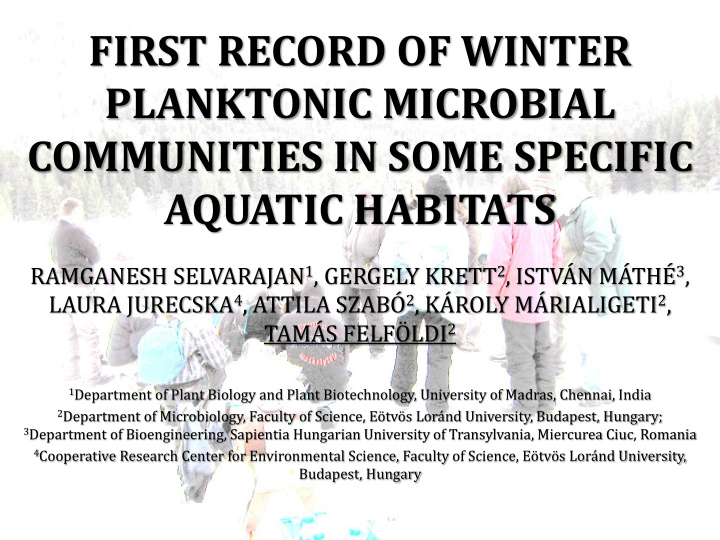



FIRST RECORD OF WINTER PLANKTONIC MICROBIAL COMMUNITIES IN SOME SPECIFIC AQUATIC HABITATS RAMGANESH SELVARAJAN 1 , GERGELY KRETT 2 , ISTVÁN MÁTHÉ 3 , LAURA JURECSKA 4 , ATTILA SZABÓ 2 , KÁROLY MÁRIALIGETI 2 , TAMÁS FELFÖLDI 2 1 Department of Plant Biology and Plant Biotechnology, University of Madras, Chennai, India 2 Department of Microbiology, Faculty of Science, Eötvös Loránd University, Budapest, Hungary; 3 Department of Bioengineering, Sapientia Hungarian University of Transylvania, Miercurea Ciuc, Romania 4 Cooperative Research Center for Environmental Science, Faculty of Science, Eötvös Loránd University, Budapest, Hungary
Life during winter is different … Lower temperature Surface ice cover (and snowpacks): reduces underwater light intensity reduces the exchange of heat, gases, particles between the atmosphere and the water coloumn prevents the mixing effect of wind …. etc. + Sampling sites are not easily accessible
…and additionally specific habitats
Aims to explore the planktonic microbial communities of these specific aquatic habitats (composition of microbial communities under the ice) Methods abundance of microorganisms: (epifluorescence) microscopy taxonomic composition of communities: denaturing gradient gel electrophoresis and sequence analysis (16S ribosomal RNA gene) physico-chemical analyses
General and measured characteristics of sampling sites 7-9th February 2013
Lake Ursu (Bear Lake)
Stratification in Lake Ursu
Upper 3.5 m layer of L. Ursu Cryptomonas sp. small green algae Pt colour - chromophoric dissolved organic matter PAR - photosynthetically active radiation P-Euk - picoeukaryotic green algae P-Cya - picocyanobacteria
Upper 3.5 m layer of L. Ursu Prosthecochloris vibrioformis
Saline lakes BACTERIA ARCHAEA CYANOBACTERIA + PLASTIDS heterotrophic, marine and/or psychrophilic prokaryotes: L. Ursu: Albidiferax sp. (B7), Polaromonas glacialis (B8), halobacteria (A6-A9); L. Verde: Marinobacter psychrophilus (B15); L. Rosu: halobacteria (A10, A11) photoautotrophs: L. Ursu: Prosthecochloris vibrioformis (green sulphur bacterium, B9- B12), Cryptomonas sp. (microscopy); L. Rosu and L. Verde: Dunaliella sp. (microscopy)
General and measured characteristics of sampling sites 7-9th February 2013
Lake St. Ana
Depth profiles of deep lakes L. St. Ana L. Ursu
Mohos peat bog lake
Apor lányok feredője pH 2.4-4.8 NH 4 + (mg/L) 1.4-2.2 NO 2 - (mg/L) 0.03-0.05 NO 3 - (mg/L) 7.5-8.2 PO 4 3- (mg/L) 0.6-6.0 Fe (mg/L) 0.5-1.2 SO 4 2- (mg/L) 327-820 TOC (mg/L) 14.3-16.5 IC (mg/L) 384-422
L. St. Ana Cryptomonas sp. Peridinium inconspicum Chl-a 1.1-1.9 µg L -1 pH 5.2-5.5 3- <0.05 mg L -1 TN <1 mg L -1 , PO 4 Mohos Euglena proxima Astasia sp. Rhodomonas sp. Chlamydomonas microscopica Chl-a 81.3 µg L -1 pH 3.9
Apor lányok 2.2-32 x 10 5 cells/mL feredője
L. St. Ana, Mohos, Apor CYANOBACTERIA BACTERIA ARCHAEA + PLASTIDS heterotrophic prokaryotes: L. St. Ana: Prosthecobacter sp. (B1), Gluconobacter sp. (B2); Mohos: Polynucleobacter necessarius (B3); Apor: Metallibacterium schefferi (B5) photoautotrophs: L. St. Ana: Cryptomonas sp. (C1-C4, microscopy), Peridinium inconspicum (microscopy); Mohos: Euglena proxima , Astasia sp., Rhodomonas sp., Chlamydomonas microscopica (microscopy), Parachlorella sp. (C7, C8) others: Mohos: Methanosaeta sp. (methanogenic archaeon, A2, A3); Apor: Acidithiobacillus ferrooxidans (acidophilic sulphur-oxidizing bacterium, B6), Ferroplasma acidiphilum (acidophilic iron-oxidizing archaeon, A4)
Conclusions Although many of the studied environments were extreme habitats regarding some or several parameters (low pH, high salinity, low light intensity etc.), microbial communities in many cases were abundant and/or diverse with the presence of previously unidentified taxa. Even phototrophic microbes may form dense populations under the ice, as it was observed in the case of the green sulphur bacterium Prosthecochloris in the stratified saline lake.
Acknowlegements Phytoplankton studies Lajos Vörös, Boglárka Somogyi, Balázs Németh Sample collection and processing Szabolcs Szilveszter, Zsuzsanna Nagymáté , Róbert Fikó , Mihály Koncz, Zsolt Gyula Keresztes, Csaba Romsics, Mihály Braun, János Korponai This work was partially supported by the grants from the Hungarian Scientific Research Fund (OTKA PD 105407), from the Romanian National Authority for Scientific Research CNCS-UEFISCDI (PN-II-RU-TE-2012-3- 0319) and from the Balassi Institute - Hungarian Scholarship Board.
Recommend
More recommend